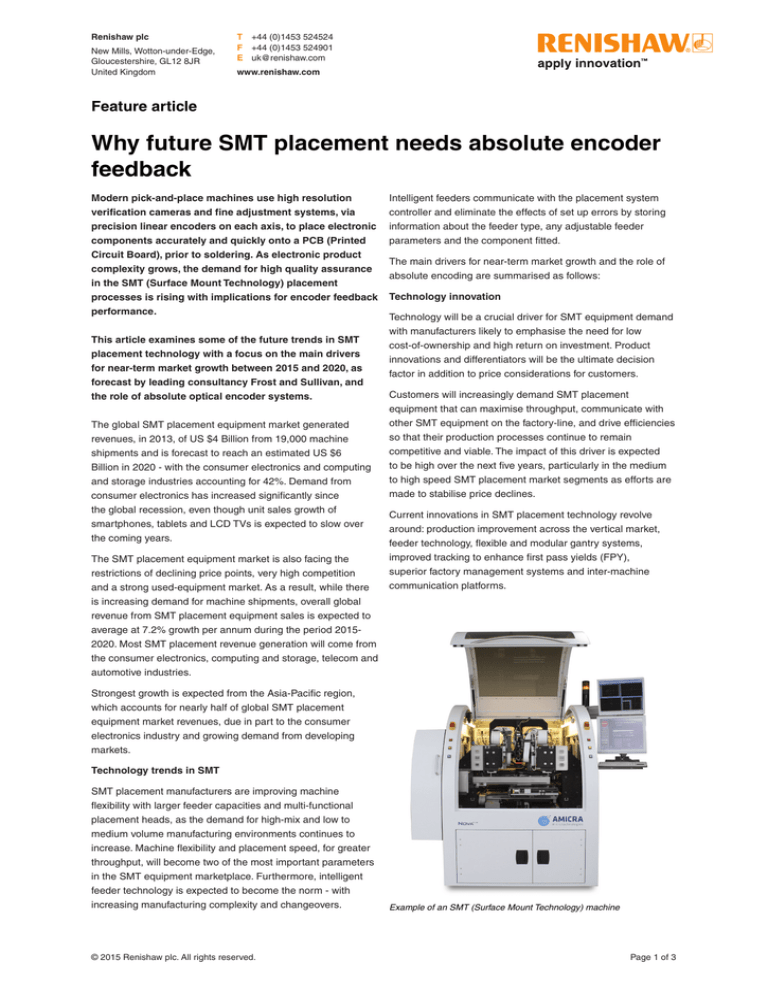
Renishaw plc
New Mills, Wotton-under-Edge,
Gloucestershire, GL12 8JR
United Kingdom
T +44 (0)1453 524524
F +44 (0)1453 524901
E uk@renishaw.com
www.renishaw.com
Feature article
Why future SMT placement needs absolute encoder
feedback
Modern pick-and-place machines use high resolution
verification cameras and fine adjustment systems, via
precision linear encoders on each axis, to place electronic
components accurately and quickly onto a PCB (Printed
Circuit Board), prior to soldering. As electronic product
complexity grows, the demand for high quality assurance
in the SMT (Surface Mount Technology) placement
processes is rising with implications for encoder feedback
performance.
This article examines some of the future trends in SMT
placement technology with a focus on the main drivers
for near-term market growth between 2015 and 2020, as
forecast by leading consultancy Frost and Sullivan, and
the role of absolute optical encoder systems.
The global SMT placement equipment market generated
revenues, in 2013, of US $4 Billion from 19,000 machine
shipments and is forecast to reach an estimated US $6
Billion in 2020 - with the consumer electronics and computing
and storage industries accounting for 42%. Demand from
consumer electronics has increased significantly since
the global recession, even though unit sales growth of
smartphones, tablets and LCD TVs is expected to slow over
the coming years.
The SMT placement equipment market is also facing the
restrictions of declining price points, very high competition
and a strong used-equipment market. As a result, while there
is increasing demand for machine shipments, overall global
revenue from SMT placement equipment sales is expected to
average at 7.2% growth per annum during the period 20152020. Most SMT placement revenue generation will come from
the consumer electronics, computing and storage, telecom and
automotive industries.
Intelligent feeders communicate with the placement system
controller and eliminate the effects of set up errors by storing
information about the feeder type, any adjustable feeder
parameters and the component fitted.
The main drivers for near-term market growth and the role of
absolute encoding are summarised as follows:
Technology innovation
Technology will be a crucial driver for SMT equipment demand
with manufacturers likely to emphasise the need for low
cost-of-ownership and high return on investment. Product
innovations and differentiators will be the ultimate decision
factor in addition to price considerations for customers.
Customers will increasingly demand SMT placement
equipment that can maximise throughput, communicate with
other SMT equipment on the factory-line, and drive efficiencies
so that their production processes continue to remain
competitive and viable. The impact of this driver is expected
to be high over the next five years, particularly in the medium
to high speed SMT placement market segments as efforts are
made to stabilise price declines.
Current innovations in SMT placement technology revolve
around: production improvement across the vertical market,
feeder technology, flexible and modular gantry systems,
improved tracking to enhance first pass yields (FPY),
superior factory management systems and inter-machine
communication platforms.
Strongest growth is expected from the Asia-Pacific region,
which accounts for nearly half of global SMT placement
equipment market revenues, due in part to the consumer
electronics industry and growing demand from developing
markets.
Technology trends in SMT
SMT placement manufacturers are improving machine
flexibility with larger feeder capacities and multi-functional
placement heads, as the demand for high-mix and low to
medium volume manufacturing environments continues to
increase. Machine flexibility and placement speed, for greater
throughput, will become two of the most important parameters
in the SMT equipment marketplace. Furthermore, intelligent
feeder technology is expected to become the norm - with
increasing manufacturing complexity and changeovers.
© 2015 Renishaw plc. All rights reserved.
Example of an SMT (Surface Mount Technology) machine
Page 1 of 3
Feature article: Why future SMT placement needs absolute encoder feedback
The recent advent of high-accuracy absolute optical encoder
systems creates new possibilities for innovations in SMT
placement equipment. Absolute encoders allow improved
performance with better reliability, faster initialisation,
enhanced safety, lower running costs and the elimination of
common crash risks.
Flexible and responsive manufacturing
Demand volatility in the electronics industry further
necessitates lean manufacturing and fast production responsetimes with a focus on flexible and responsive manufacturing
lines. Demand for highly-flexible production gives rise to
multiple-head, multiple-axis machines with dual or quadgantries and flexible conveyors requiring coordination of
complex placement paths. Incremental encoder systems
require that all axes home to a reference position (reference
return) when restarting production after stoppages - only
in this way is the control system able to detect the actual
position of the axes. The homing of multiple-heads from
an undefined location on an axis is a significant source of
additional machine downtime. If the operator has not analysed
the crash paths first and selected the reference travel cycle
accordingly, the installations can suffer considerable damage
as a result of the collision of placement heads or even of the
gantries themselves. This leads to longer unproductive times,
unnecessary costs and uneconomical downtimes of the entire
machine in the event of a crash.
Another advantage of absolute encoder systems is that they
calculate position on demand and Renishaw’s RESOLUTE™
encoder is the first to combine this feature with built-in error
checking algorithms that instantly flag any misreading of scale.
This protects against uncontrolled movements and related
crash risks by eliminating scale miscounting, position drift and
count runaway, with benefits to yield, throughput and safety.
Absolute encoders, therefore, improve process reliability,
reduce unproductive time and prevent expensive crashes.
Revolver-head placement machine: a relatively new technology
designed to maximize the placement speeds of flexible gantry
systems. Credit: Handbook of Electronic Assembly and Guide to SMTA
Certification. 2014. SMTA
Miniaturising SMT component sizes
Another area of focus includes the need to address the smaller
footprint and lower cost per board aspects. Consumer products
are becoming extremely densely populated and physically
smaller, leading to demand for automated and highly-accurate
placement requirements. The electronics industry is reducing
end-product dimensions with increasing use of smaller passive
components, such as the 01005, with size factors approaching
<0.5 mm, ultra-fine 0.3 mm pitch / high pin count Quad Flat
Packages (QFPs) and flip-chips with 150 µm pitch. Higher
assembly densities will increase demand for automating
SMT placement equipment that reduces the cost per board
with advanced software and feeder technology, enhanced
placement accuracy and higher speed. Furthermore, rising
numbers of customers are choosing to upgrade either legacy
SMT placement equipment or the complete software platform,
which should also help to drive market growth over the coming
years.
RESOLUTE absolute optical encoder on a linear axis within a SMT machine
© 2015 Renishaw plc. All rights reserved.
Page 2 of 3
Feature article: Why future SMT placement needs absolute encoder feedback
High-performance devices are likewise expected to drive
demand for state-of-the-art SMT software platforms. As
product complexity continues to grow, the demand for high
quality assurance in high speed placement processes is rising
and overhead-gantry type and revolver head systems, whereby
a revolving placement head is mounted on a gantry beam that
moves in the X and Y directions, will increasingly dominate.
Machines must be capable of placing many thousands of
components at high speed, >100,000 components placed per
hour (CPH) for chip shooters, with high accuracy positional
(X,Y) and rotational (θ) alignment to ensure increasingly
exacting quality standards. Modern pick and place gantry
systems require encoders to be capable of high speed
(for increased throughput) and high resolution (for placing
small components). Digital incremental encoders have a
maximum speed that is determined by the maximum input
frequency (MHz) of the receiving electronics along with the
desired resolution. Consequently, as the maximum receiving
electronics frequency is fixed any increase in resolution
will result in a corresponding decrease in maximum speed
and vice versa. Absolute encoders do not suffer from this
compromise and allow for both high speed and high resolution
operation. This is due to the position being determined on
demand and the use of serial communications, allowing gantry
designers the freedom to operate at both high speeds and
high resolutions.
Increased complexity of printed circuit boards (PCB) due to
the miniaturisation trend across multiple industries is further
boosting demand levels. The SMT placement equipment
market is experiencing significant new growth opportunities
within Central and Eastern Europe for consumer electronics,
telecom and automotive electronics manufacturing. The region
is also attractive for low-cost manufacturing locations for the
top global providers, which is further expanding demand for
SMT production equipment. The Asia-Pacific region remains
the largest generator of SMT revenues and leads demand for
high-speed SMT placement equipment.
The wider adoption of high-performance absolute encoder
systems will allow SMT placement equipment manufacturers
to keep up with the increasing technological demands of the
electronics industry. Encoder technology employed within SMT
placement equipment is directly responsible for improving
placement accuracy and repeatability as well as increasing the
speed of each axis, thereby boosting machine throughput to
higher levels.
For more information, visit
www.renishaw.com/encoders
Renishaw would like to thank Prof Ronald C. Lasky Ph.D., PE,
from the Thayer School of Engineering, Dartmouth College, for
his expert advice.
SMT placement machines are also increasingly using linear
motors on the X and Y axes, to enhance accuracy, speed, and
servo-loop stiffness. Absolute optical encoders output reliable
signals of high fidelity that permit higher servo-loop gain
levels. High servo-loop gain allows increased axis acceleration
and deceleration, faster settling times and reduced induction
motor heating - enabling the machine to run harder and for
longer while reducing the number of scheduled stoppages
required for cooling. Absolute encoders further allow correct
commutation to be found immediately without reference
returns; enabling simpler servo-design and a reduction
of assembly complexity when compared with incremental
encoder-based systems, which require additional sensors,
e.g. Hall effect sensors, to commutate the linear motor.
Moreover, the error checking algorithms of the RESOLUTE
encoder enhance placement reliability by reducing board
misplacements, which helps to maximise yield (FPY) and
lower the total cost-of-ownership.
The future of SMT placement.
Fast-moving commercial markets, which demand a
succession of sophisticated high-technology products,
are dominating the electronics manufacturing scene. This
trend is compelling manufacturers to keep pace with the
continuous miniaturisation and convergence of different
technologies by developing increasingly flexible, modular
SMT placement equipment. In addition, the use of wireless
technology in medical devices is growing rapidly – requiring
high-mix production, with smaller batch sizes, and resulting
in heightened demand for flexible SMT placement equipment.
© 2015 Renishaw plc. All rights reserved.
Page 3 of 3








